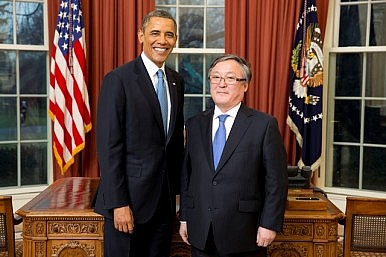Rio Tinto Group, the world's second-largest mining company, is locked in talks with Mongolia over developing the second stage of the Oyu Tolgoi copper and gold mine, saying only a few matters remain on the table.
"We are down to a few issues and these issues are deal breaker type issues," chief executive Sam Walsh said Saturday in an interview in Ulaanbaatar. "And we are not asking for anything that is out of the ordinary or special to Rio Tinto."
Talks are aimed at resolving a stalled $US5.4 billion expansion of the Oyu Tolgoi project, Rio-controlled Turquoise Hill Resources said. Mongolia's Prime Minister Saikhanbileg Chimed said in December that resolving wrangles with Rio over taxes and cost overruns was a priority.
While commitments from lenders for $US4.2 billion needed to help fund the development expired after a September 30 deadline a "suitable financing package will be available once we have successfully resolved the outstanding matters," Turquoise Hill CEO Jeff Tygesen said in an earnings call.
Oyu Tolgoi, located about 80 kilometers (50 miles) north of the Chinese border, will contribute about a third of Mongolia's economy when in full production and will be the world's third- biggest copper mine, according to Turquoise Hill.
Walsh said he is very "patient and hopeful" that an agreement can be reached, adding that the Rio has no plans to exit the project.
A senior Mongolian government group recently visited the mine, said Walsh, in order "to understand more about how it operates and what are the complexities and issues associated with running a project of such huge scale and operations."
"I am hopeful that a solution is more a matter of transparency, awareness (and) communication," said Walsh, who planned to visit the mine on Sunday to participate in an event to mark 1 million tons of copper concentrate exports.
A sticking point in the talks has been a claim of around $US30 million in taxes that Mongolia says it is owed by Oyu Tolgoi. Rio denies the charge.
"We do not believe that amount is due and we will continue to discuss with the Mongolian government and if necessary we will go to international arbitration," said Walsh. Any possible writedown of the underground project is an issue for auditors and accountants, he said. "At this stage by not spending the dollars you actually push out the point where you would consider the carrying value for the project."
A reorganisation of Rio's business units which brought coal assets under the managements of the producer's copper chief Jean-Sebastien Jacques isn't a signal toward a potential exit from the commodity, Walsh said.
Walsh declared coal "a major part" of Rio's portfolio, in the interview Saturday, adding that "carrying the overhead of a standalone product group is something we couldn't support going forward."
Around $US800 billion in annual costs had been taken out of Rio's coal business, he added.
The overhaul, which saw energy unit CEO Harry Kenyon-Slaney leave the company, could be seen as the first step in a longer term exit from coal, Jefferies analyst Chris LaFemina wrote in a report dated February 26. Jefferies estimates Rio's coal business is worth about $US3.6 billion.
Walsh reinforced his rejection of a proposal last week by Fortescue Metals Group chairmanAndrew Forrest for big iron ore producers to cap output to help support prices. Forrest's call prompted Australia's competition watchdog to seek an explanation.
The proposal "is against international law, that is why I said it was absolute nonsense and of course that is why Rio Tinto would not consider such a proposal," Walsh said in clarifying statements on Saturday.
The outcry missed the "elephant in the room," Forrest said in an interview on the sidelines of the Boao Forum for Asia with Bloomberg Television on Saturday, adding that Fortescue will behave responsibly.
""There's a national interest issue here," Forrest said. "China's national interest, Australia's national interest, isn't helped by companies dumping iron ore into a foreign market."
Iron ore slumped 47 per cent in 2014 and has extended losses this year, touching the lowest since at least May 2009.






